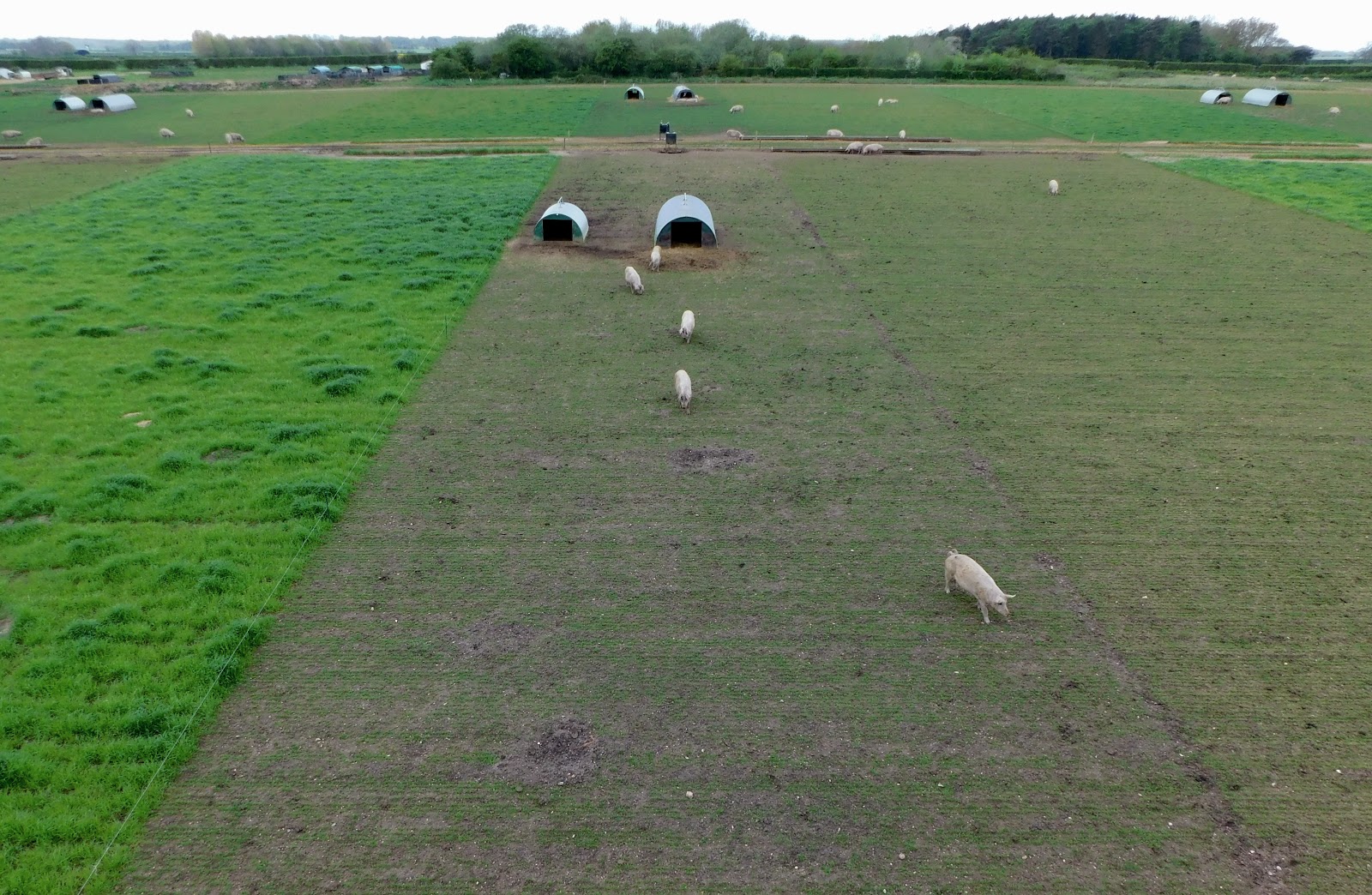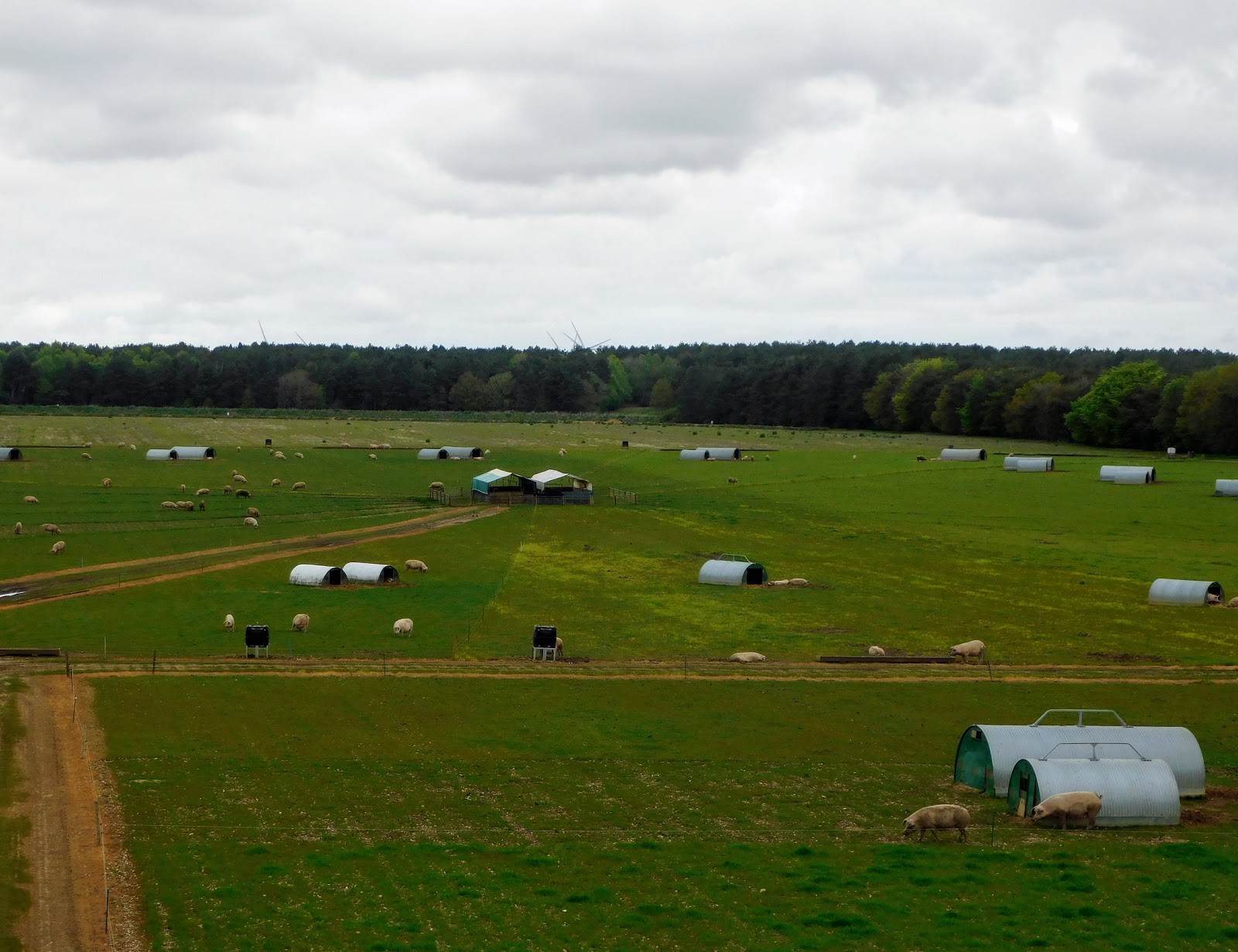Grass cover mix options compared on outdoor units
Monday, 7 June 2021
A unique trial is underway to find out how both pigs and the environment can benefit from sowing grass cover mixes to improve soil management on outdoor units.
It is the latest initiative to come out of the strong collaboration between East Anglian pig producers, their landlords and organisations including Norfolk Rivers Trust, Anglian Water, Catchment Sensitive Farming (CSF), the Environment Agency and Kings Crops, established through a number of meetings that we have held over the last six years.
“By bringing everyone together, great progress has been made in basic soil management and effective ways to minimise run-off,” said Knowledge Exchange Manager, Andrew Palmer. “We have also focused on cultivating good working relationships between producers and their landlords, which is crucial.
“The grass cover trial is the next exciting step forward, to understand more about how proactive management to protect the soil can be mutually beneficial to pig production, water quality, the arable rotation and biodiversity.”
Sward mix options
Not all producers have a long lead-in time and access to sites may be limited, so the trial is looking at different cover mixes which are quick-growing and allow pigs to go on after a shorter time, while helping improve the soil. A standard pig seed mix is being compared against fallow and herbal mixes, with cover swards sown just after the cereal harvest in autumn, and pigs moved on in spring.
The aim of the trial is to investigate which mixes are good to establish on light soil and how they perform in these key areas:
- Establishment and longevity/persistence
- Ability to cope with pigs (grazing and potential poaching)
- Pig productivity and economics
- Soil structure
- Soil nutrient retention – minimising phosphate and nitrate losses through surface run-off and leaching to groundwater
“A cover sward’s ability to reduce surface run off is particularly important given wetter winters are more common now,” said Ed Bramham-Jones of Norfolk Rivers Trust.
“The great thing about green cover is that the leaf cover provides physical protection to the soil itself. The roots are also binding the soil, holding in nutrients, and keeping the structure in place. On lighter soils, there’s protection against wind erosion too,” he said.
The trial is running on two different sites. On the first, eight hectares has been planted with a standard pig seed mix, which is hardy and grows back well, and a further eight hectares with a fallow mix, including rye, vetch and other pollen and nectar-producing species. “There will be areas not grazed or rooted where there is potential for these grasses to flower, which will be beneficial to biodiversity,” said Mr Bramham-Jones.
“The second site has a total of 20 hectares with 10 hectares of the standard pig mix and 10 hectares of herbal mixes, which include non-legume species, such as chicory and plantain; the trial will monitor soil mineral nitrogen to see if there are any differences between mixes in terms of nitrogen retention.”
Site details
- Light soil, following winter barley
- 8 ha of each sward mix, sown 10–12 August 2020
- Pigs moved on in late January/early February 2021
Grass cover mixes
Tough pig mix: Strong creeping red fescue, intermediate perennial ryegrass, late perennial ryegrass, late perennial ryegrass (35 kg per ha)
Fallow/pollen and nectar mix: Italian ryegrass, vetch, birdsfoot trefoil, red clover (20 kg per ha)
Site details
- Medium-light soil, following winter wheat
- 10 ha of each sward mix, sown 19–20 August
- Pigs moved on in late January/early February
Grass cover mixes
Tough pig mix: as above
Pig herbal mix: Tall leaved fescue, festulolium, perennial chicory, plantain, agricultural burnet, yarrow (28 kg per ha)
Producer benefits
Producer Rob McGregor, of LSB Pigs, who manages the two trial units, sees a number of potential benefits to the land, pig welfare, the working environment and the aesthetics.
“Grass helps with enrichment, and also, when it comes to farrowing, the amount of fibre in the green forage going through the sow’s gut means there are less likely to be problems with constipation,” Mr McGregor said. “It’s a nicer place to work with no soil blowing around and easier for the team to take pride in it. You have to do everything you can to maintain it for the whole time the unit is on that land.
Mr McGregor is very pleased with how well the trial covers have established. “We drilled it ourselves as our landlord was busy elsewhere,” he explained. “It was a bit of a learning curve, but it meant we planted at the ideal timing.”
In April, there was still well above 90% green cover, with signs of wear by the water tanks, in front of the arks and long feeding troughs.
“On the dry sow blocks, sows wander and use the entire paddock area,” Mr McGregor said, “But, in the service radial, sows spend a lot of time between the arks and the outer fence line where the feed troughs are, leaving the fence nearer the central hub less used. So we’ve now set the dry sow arks nearer the centre than normal.”
Planning ahead
Usually, Mr McGregor would move sites in the autumn, but as he wanted to give as much time for the cover to establish as possible, he arranged a spring move with their landlord. “The fields we were coming off were going into sugar beet, and we started our move earlier than expected, in late January/early February, when it was a bit wetter than we would have liked.
“There was a bit of damage at one of the units, where it was a bit damper, and the land had been continually cropped without deep cultivation or pigs on it; pigs can have a similar effect to subsoiling.”
If producers are moving pigs on to green cover, Mr McGregor suggests planning two to three years ahead and doing some deeper cultivation to help prevent surface waterlogging.
“Have a conversation with your landlord to review timings and moving plans,” he advised. “Those relationships are essential. While the landlord might need to make compromises, it’s also a benefit to him if we can retain more nutrients in the soil and help prevent wind and rain erosion.”
“There’s been feedback from landlords about the benefits of a collaborative approach,” added Mr Bramham-Jones. “The data from the trials are helpful to Rob’s landlord too, providing information on soil biota, nutrient retention and nematode numbers, ready for the following crop,” he said.
Following crop benefits
Teresa Meadows, Knowledge Exchange Manager for AHDB Cereals & Oilseeds, is keen to understand more from the trial about managing the soil before, during and after pigs go on.
“It will be good to know how long the covers will last while the pigs are there and also to be able to start to quantify the benefits to the following crop, in terms of nutrient levels and utilisation, soil structure, soil health and water management,” she said.
“The benefits may not necessarily be realised in the crop immediately following pigs, but later on in the rotation,” Ms Meadows added. “Also, improvements in soil structure may enable reduced cultivations for landlords for the establishment of the following crop, allowing a reduction in fuel use and wider costs.”
Further information
Listen to our podcast to find out more about the trial
Find out how grass cover mixes fare during summer heatwaves (October 2022 update)
Cover trial proves grass is an eco-asset on outdoor sites (Pig World, August 2023)
Topics:
Sectors:
Tags:



